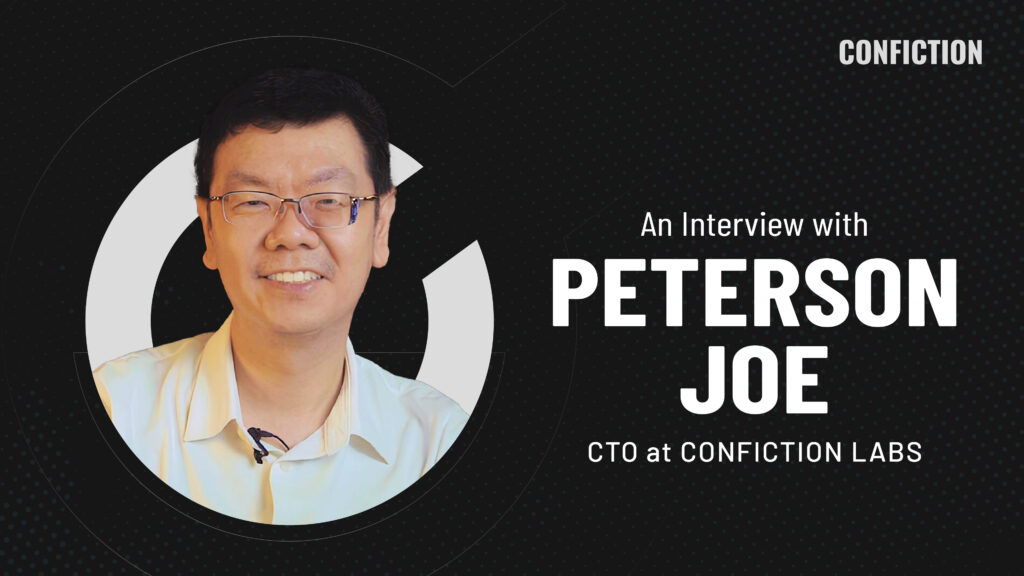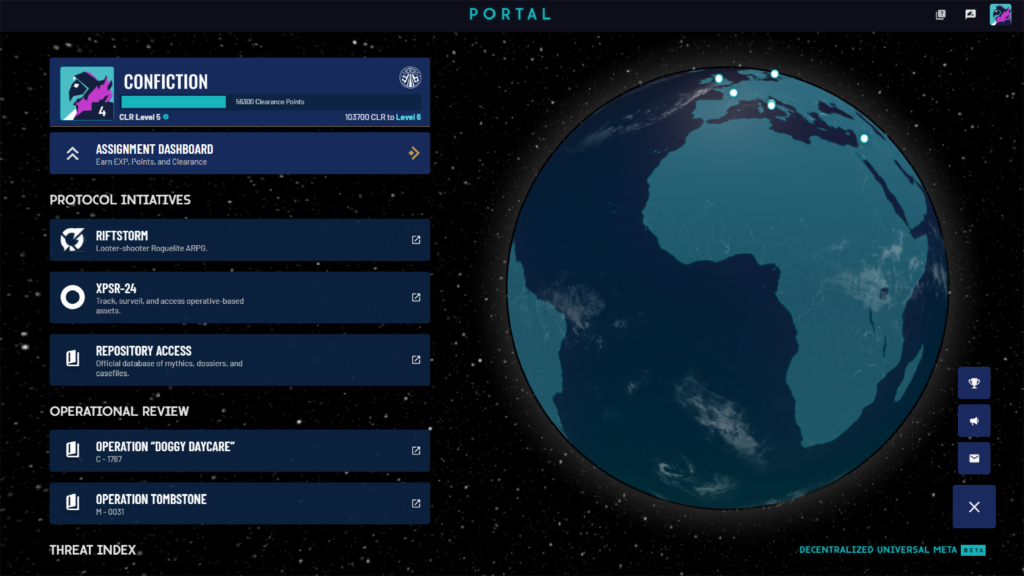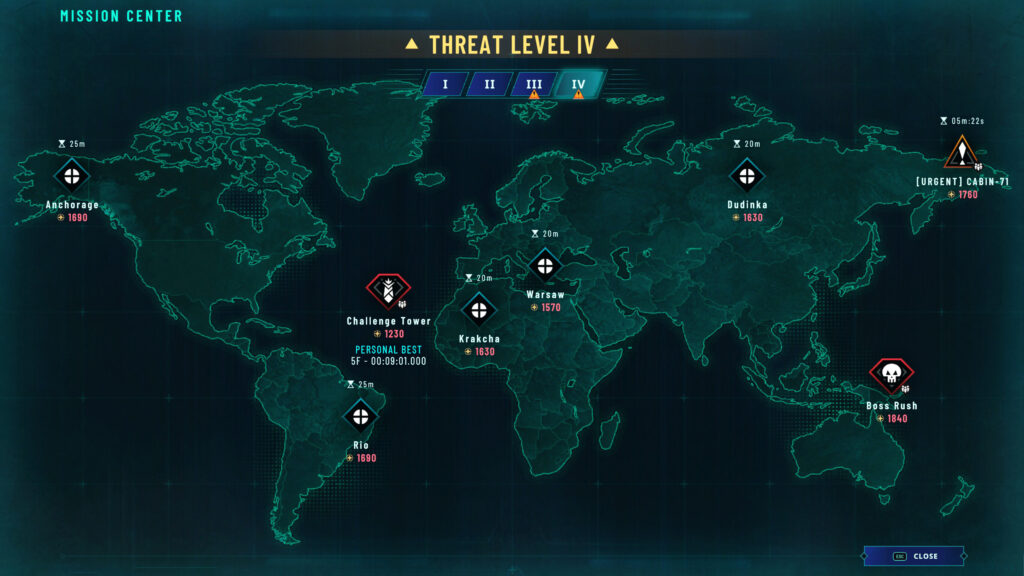
Peterson Joe is the technical wizard working behind the scenes at Confiction Labs to develop RIFTSTORM and everything connected to the Occultical universe. Excited by the idea of driving Collaborative Entertainment through emerging technologies such as web3 and AI, Peterson shares a similar view with the rest of Confiction’s core team on building the next IP that changes how companies approach entertainment. As the Chief Technology Officer at Confiction Labs, Peterson oversees each building block of RIFTSTORM and Occultical, making sure they seamlessly work together.
After discovering his passion for programming at eight years old, Peterson went on to pursue the craft and honed it until adulthood. He found himself part of an insurance sales team, eager to learn more about how he could market his skills. He worked in the insurance industry for five years, making his way to General Manager before quitting to continue his pursuits in programming. After completing a master’s degree and returning home to Indonesia, Peterson started a business in software development and worked in the space until he rediscovered his passion for game development. From there, he built a successful tech company and later sold it.
At Confiction Labs, Peterson makes sure that the technology behind RIFTSTORM is running smoothly without intruding on the players’ experience. His team’s recent accomplishments include the Portal and Proof of Exposure. He also works closely with the rest of the team to make sure RIFTSTORM is enjoyable while setting up the integration of Collaborative Entertainment through features such as the Repository.

You’ve had experience building a game studio and later selling it. What are the most significant learnings you’ve acquired now that you’re part of Confiction Labs?
Peterson: Running your own company provides valuable experience in ensuring that all processes operate smoothly and efficiently. In the tech industry especially, a lot of people think that once you graduate from college, you’re ready to develop a software program. That’s not true. Just because you are an engineering major doesn’t mean you know how to build a bridge properly. The same goes for programming. Fresh graduates need a bit more time to learn professional software development and the process can differ depending on the company and what they are building.
Confiction Labs also has its own set of challenges. This is the first time we are working with blockchain and web3 technology. It’s a good learning experience for everybody, and it’s also exciting playing around with new technology. My previous experience has given me a comprehensive understanding of game development, helping the team make more informed decisions.
“We didn’t want to put additional pressure on players to have to understand all the web3 elements and jargon. We wanted to design everything so someone can just play the game without worrying about what’s running behind the scenes.”

The third RIFTSTORM playtest is coming up. What are the new features that we should expect to see?
Peterson: In terms of new features, the big shift that we are introducing is to make RIFTSTORM feel more like a fully realized game. In the previous playtest, our goal was to make the core gameplay loop feel fun to play, even in a context-free setting. You just jump into the game and start shooting. You don’t know what the game is all about. So now it’s more of a game than a tech demo. We have put in a lot more content and dive deeper into this secret society fantasy, which means adding new features that help build that immersion — from audio lines, intractable objects, to cutscenes.
From a more technical perspective, we internally worked on what we call Dungeon System 2.0, which is our way of generating random levels in a more freeform layout. In RIFTSTORM, we have a mix of handcrafted areas designed to maximize the gameplay experience and roguelite elements where every time you start the game, everything about the layout changes. In the first playtest, the maps were blocky because we wanted to test other mechanics. With the new implementation, level generation is more freeform and levels feel more organic when you move from one area to the next.
What are the biggest technical challenges you’ve faced while building RIFTSTORM?
Peterson: For RIFTSTORM, it was our first time building a game in web3, so there are a lot of elements that we had to solve. As much as possible, we didn’t want to put additional pressure on players to have to understand all the web3 elements and jargon. We wanted to design everything so someone can just play the game without worrying about what’s running behind the scenes.
Web3 itself is very community-driven, which adds additional challenges. We are building the ConFict Data Layer (CDL), which will help facilitate submissions from players, creators, and fans later on. It’s one of the ways we are giving power back to the gamers.
“We are building the foundation for how we can build IPs in the future. With Collaborative Entertainment, we see the power of decentralization and community building, where people collaborate to develop the IP to make it grow faster and of a higher quality.”
What web3 elements are planned for RIFTSTORM?
Peterson: Confiction Labs has a lot of moving parts and many projects. One of the main things we’re working on is abstracting away the web3 elements so that the experience is seamless for players. We also have a lot of connected products, like the Portal and the Repository, where users can submit content that can be incorporated into RIFTSTORM. These are the things that take time to develop.
We are building the foundation for how we can build IPs in the future. Franchises like Star Wars or Harry Potter took a lot of time to get to their current popularity. With Collaborative Entertainment, we see the power of decentralization and community building, where people collaborate to develop the IP to make it grow faster and of a higher quality. You could build your own stories or monsters, and then when the community likes it, they can build stories around it. The only difference with RIFTSTORM is that we’re starting with a game instead of a film or novel.
To make that vision possible, we need to have the platform ready and products such as the Repository so people can submit their ideas. We are still working on it, but it will be ready eventually. For now, we are doing playtests with events that affect future storylines. We had some artists produce comics that reflected the results of those previous playtests.
What are the challenges that Collaborative Entertainment presents from a technical perspective?
Peterson: There are a few challenges. You need to build the platform that allows user-generated content, and you have to consider how it works for web2 games because there’s also a lot of UGC there. If you think about it, the transition from web1 to web3 has been opening the doors for more people to contribute. In web1 during the 1990s, people could read but very few could create content. Today in web2, you have websites like YouTube that don’t function without user-generated content.
Web2 has already solved how to incorporate UGC. What web3 changes is collaboration through decentralization. You upload a video on YouTube but don’t capture the majority of the monetization because the video is essentially YouTube’s property. What we’re doing is a way to track everyone’s submissions. Blockchain solves this as a transparent ledger tracking transaction origins. The first challenge we had to tackle was incorporating blockchain into what is already a web2 structure for UGC.
On the operational side, we need to ensure that our system evaluates submissions and whether they are of sufficient quality while also considering the popularity of the submissions. So we’re working on integrating voting systems but we need to be careful, especially in the early part of IP development. If we open up everything immediately, the risk is ending up without a clear direction of where the IP wants to go. Imagine if there were no rules at first when Harry Potter or Star Wars were created. A developer still needs to set that foundation, and then we can open up decentralization as more people understand our vision.
“Blockchain and AI are an intriguing combination because they complement each other yet possess contrasting characteristics.”
What is the technical aspect that excites you the most in terms of game development?
Peterson: Programmers are always very excited to work with new technology. Blockchain and AI are an intriguing combination because they complement each other yet possess contrasting characteristics. AI can help create something, but it needs to centralize data so it can make accurate decisions. On the other end, web3 is inherently decentralized.
I think AI really helps fill in the skill gaps. If I am a writer and want to contribute, I can write a story, but I don’t know how to draw. Generative AI can create the images I need that fit in with my style so that the submission has a lot more context. What’s exciting about blockchain technology is that you can now see who is the origin of that submission. Everybody will see that. Just figuring out how these two new emerging technologies and how to combine them have been enjoyable.
What do the next 12 months hold for Confiction Labs?
Peterson: The next 12 months will be very exciting. We started this project more than two years ago, and a lot of the work was behind the scenes, building the product before we could think about selling it. In the next year, we’ll be seeing a lot of what we built come to fruition. The upcoming third playtest will feature more of what will be coming out in the actual game, especially the lore. In the next year, we’ll have a more substantial release for our players.
Earlier this year we finished our Genesis pass, FICT ZERO and now we’re working on our main collection, the XPSR-24 NFTs. We have a lot of things planned for that, especially during the game’s release, where digital assets and all of that are going to be working as we envisioned them.
Wishlist RIFTSTORM on Steam to join the third playtest for free.
Follow Confiction Labs and RIFTSTORM on X for the latest news and other information. Learn more about XPSR-24 in this article.

